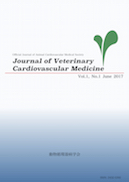A 9-year-old, male neutered, mixed breed cat was presented to JASMINE cardiovascular medical center for severe azotemia and anuria. On the initial consultation, increase in BUN (>140 mg/dL) and creatinine (15.1 mg/dL) were noted. Serum potassium concentration was also elevated at 9.8 mEq/L, which resulted in absence of P waves and widening of QRS complex on electrocardiograms. From history, course of treatment, and diagnostic test results, acute renal failure due to ingestion of nephrotoxic material was diagnosed and peritoneal dialysis was initiated for renal replacement therapy. On day 3 of hospitalization, a disc shaped peritoneal dialysis catheter was placed caudally to liver and diaphragm under general anesthesia. Peritoneal dialysis was performed by filling the abdomen with dialysate. After 2 to 3 hours of dwell time, dialysis solution was drained under gravity.This process was repeated several times a day. On day 6 hospitalization, urine output was noted and on day 8 the patient showed improvement in overall wellbeing, and by day 9, the patient had started eating. Gradual improvement of blood values were observed over the course of treatment and both BUN (62.8 mg/dL) and creatinine (2.2 mg/dL) showed marked decline in value at the time of discharge. It has been 1 year and 8 months since the peritoneal dialysis and both BUN and creatinine values are within normal range and the cat requires no treatment. This case has demonstrated the effectiveness of peritoneal dialysis by placing the disc shaped peritoneal dialysis catheter caudal to liver and diaphragm without causing dislodgement or obstruction of the catheter.
View full abstract
